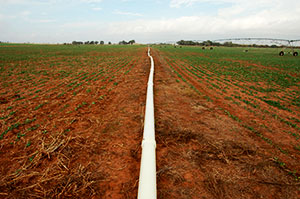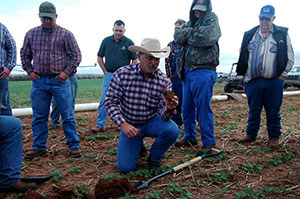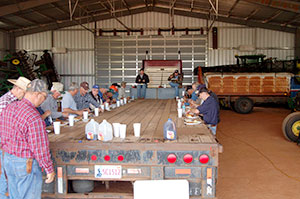Dewey County Demonstrates Value of Cover Crops to Local Producers

Dewey County Conservation District (DCCD) and the Natural Resources Conservation Service (NRCS) gathered with over 20 local producers for a cover crop information field day on October 30, 2013 at DCCD board member Jimmy Emmons’ farm to learn about the benefits and challenges of using cover crops.
A cover crop is planted in the time between crops intended for harvest with the purpose of insulating soil from extreme temperatures and erosion and boosting biodiversity and nutrients below the soil.
“The basic idea is to keep something green and growing on the soil year-round,” said Steve Alspach, NRCS Assistant State Soil Scientist.
Emmons Gives It a Try

Emmons has been practicing no-till farming (literally: not tilling the soil) for some time now, and wanted to give cover crops a try. He spoke with his local NRCS office and they provided the technical assistance necessary to order a mix of cover crop seeds that was most compatible with his soils. They have also been assisting him in documenting the results of his experiment.
In the experiment field, which is divided down the center by an irrigation pipe, farmers from across Dewey County huddled around Emmons and Alspach as they explained the differences between the two halves of the field. Both sides were covered in lush green canola sprouts, but in the areas between plants, there was a big difference. On one side of the field, thick mats of plant residue and dead stalks littered the ground between sprouts. On the other side, the soil was nearly bare except for the bit of stubble remaining from the previous harvest.
How No-Till and Cover Crops Work Together
As the pair spoke, an efficient cycle began to materialize that integrates no-till farming, cover crops, and the natural processes that nature has already put in place to sustain plant growth and productivity.
The cycle begins in the core no-till concept “Do Not Disturb [the soil].” By not turning up the ground with a tiller, old root systems and worm channels abound, providing natural aqueducts for rainwater to penetrate the soil. Not disturbing the soil also gives organisms in the soil a chance at life. Adding a cover crop between harvests provides continuous food for that life, ultimately returning nutrients to the soil for future crops to use. The cycle begins anew after a crop is harvested from the field, but not tilled, so the organic matter can naturally breakdown into the soil as food and provide protection from erosion.

Cool Soil Means Better Crops
“Soil temperature is one of Oklahoma’s biggest challenges due to evaporation,” said Alspach.
Regular comparisons of the two field halves showed that the cover crop significantly reduced soil temperatures relative to the uncovered half. And while traditional wisdom says that cover crops will simply take moisture from the soil that could be used for a cash crop, the covered field actually had consistently more moisture in the soil due to reduced heat related evaporation.
“Once your soil temperature is over 100 degrees, it doesn’t matter what you’ve got growing on it,” said Alspach. “It’s not doing anything for you other than trying to survive. It’s not growing. It’s not producing.
Rainfall Simulator Steals the Show
After a standing lunch eaten at the flatbed of a hay truck, the crowd got to see one of the most impressive arguments for no-till: the rainfall simulator.
The simulator looked like a metal table with five baking pans across it side-by-side. The pans tilted downward from one end at a gentle angle and had pencil-sized holes punched into their bottoms. Instead of cake, the pans were filled with different soil samples such as that from a traditionally tilled field, a no-till field, and a cover crop no-till field.
Below the table hung ten large plastic jars. For each soil sample, one jar hung directly below the pan, and another other was out in front of the pan beneath a funnel. Above the table was a mounted sprinkler attached to a garden hose. When the water was turned on, the sprinkler pivoted back-and-forth over the pans, soaking the soil below. Water that was absorbed by the soil was collected in the jar below the pan, and water that ran off the soil was collected in the jar out front.
When the water was turned off, the benefits of no-till were abundantly clear. The jar in front of the traditionally tilled soil was full of water and brown swirling topsoil. Each of the other samples had full water absorption jars and almost no runoff.
The hosts considered the day a success, but the rainfall simulator stole the show. It offered a powerful visual demonstration of how much topsoil washes off a tilled field in even a brief rain. And the cover crops were a big hit, too!
